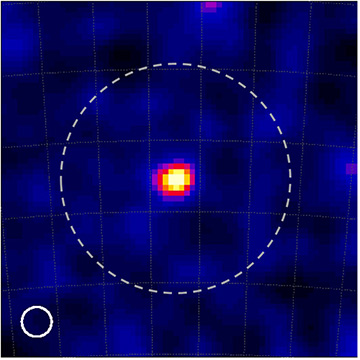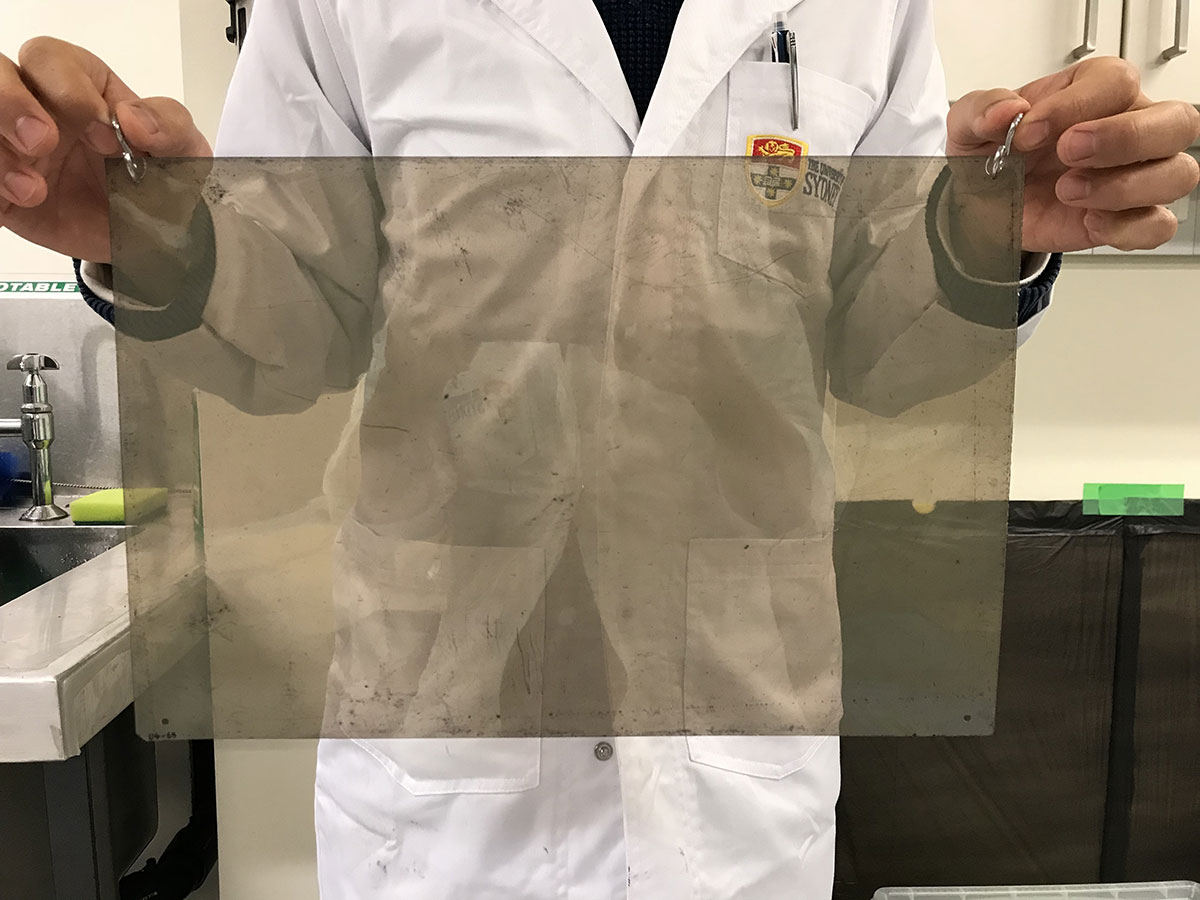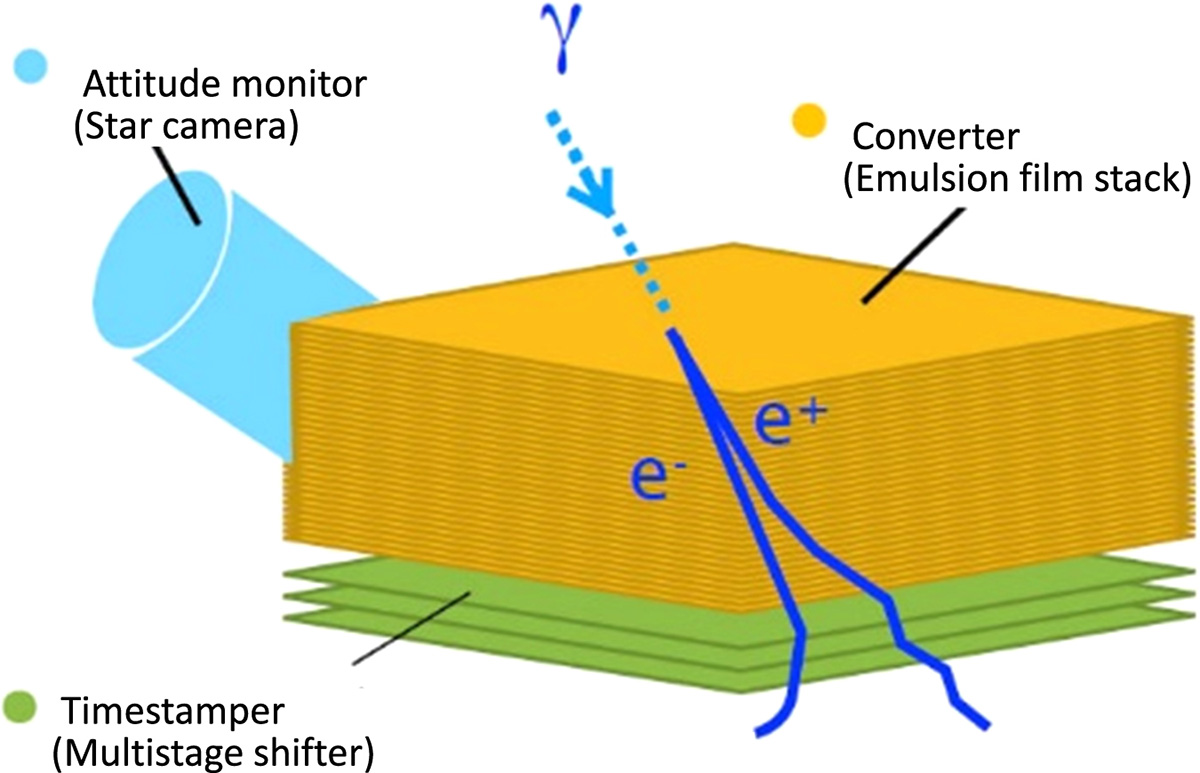A team of researchers from several Japan universities has developed a balloon-borne gamma ray observatory consisting of a stack of scores of thin emulsion films. The particle traces attributable to the rays appear as tiny dots on each individual film layer. [Image: GRAINE collaboration]
In an age of instantly available, high-resolution digital imaging, it’s easy to conclude that an older photographic technology—traditional emulsion-based films—has little extra to offer. Yet emulsion films, it seems, still have their uses.
A case in point: In newly reported work, a Japan-based scientific team used a novel “telescope” consisting of a “pancake stack” of emulsion films to image gamma rays from the distant Vela pulsar with what the authors say is “the highest angular resolution of any gamma-ray telescope to date” (Astrophys. J., doi: 10.3847/1538-4357/ad0973). For good measure, they also leveraged another technology with long historical roots—a scientific balloon to take the film-stack-based telescope to a high altitude for a good look at the gamma-ray sky.
During a 900-km balloon-borne flight across central Australia, the seemingly awkward instrument was able to capture “several trillion tracks” of gamma-ray-derived electron-positron pairs, with “an accuracy of 1/10,000 mm,” according to study coauthor Shigeki Aoki of Kobe University. And, Aoki adds, the film-based instrument’s precision allowed a measurement of the pulsar with a resolution “more than 40 times higher than that of conventional gamma-ray telescopes.”
Toward better gamma-ray measurements
There is, of course, no dearth of gamma-ray telescopes today. The Earth-orbiting Fermi Gamma-Ray Space Telescope, for example, was launched in 2008 and has made paradigm-shifting observations in its long mission, as have other spaceborne missions such as the European Space Agency’s INTEGRAL observatory. Multiple ground-based observatories also survey the gamma-ray sky.
The problem with current gamma-ray telescope technology, according to the new study, is that it falls short both in resolving the incidence angle of the gamma rays and in sensitivity to polarization. Improving these deficiencies, the authors maintain, is “key to achieving the next breakthrough in the field of gamma-ray astronomy.”
Pancake stack (hold the syrup)

An unusual press image compares the stack of emulsion films in the team’s novel detector to a stack of pancakes, and the gamma-ray track to a straw going through the stack at an angle. [Image: Kobe University]
More than a decade ago, the researchers behind the newly reported work hit upon a solution to the quandary. By stacking a large number of gamma-ray-sensitive emulsion films, they could capture the tracks of electron-positron pairs created by the gamma rays (through the process of pair production) as they passed through each layer of the film stack.
In a press release (and a rather kitschy image) accompanying the research, the stack of emulsion films is compared with a stack of pancakes. Just as the angle of a straw stuck through the pancake stack can be measured by the position of the hole in each successive layer, so the angle of the gamma-ray incidence can be similarly backed out of the film stack—with superior angular resolution. And, since the azimuth of the plane of the electron-positron pair correlates (albeit weakly) with the gamma-ray polarization, the setup can also be used for polarization measurements.
Position and time control
The team put this concept together with some clever additional systems for position and time control for their balloon-borne observations. The crux of the device, which the researchers call the “converter,” is a 33-mm-thick stack of 100 film layers, each 330 µm thick and each including a 75-µm-thick emulsion layer of silver bromide crystals. The converter is designed to detect and track the pair-produced electrons and positrons across a statistically meaningful distance, and enable the angular measurement.
A schematic of the team’s emulsion-film gamma-ray detector. [Image: S. Takahari et al., Astrophys. J. 960, 47 (2024); CC-BY 4.0]
The team also needed to ensure that it could reconstruct the precise position (specifically the attitude) of the balloon-borne instrument and the precise timing for each of the captured gamma-ray tracks. For the first requirement, the researchers used a set of three star cameras separated by 90 degrees in azimuth. This allows the instrument’s orientation relative to the fixed stars to be recorded, and the attitude of the instrument to be thus measured and corrected for in each observation.
To determine the timing, meanwhile, the team developed an ingenious “timestamper,” consisting of three horizontal stages of additional multilayer films—with each stage rocking back and forth beneath the stationary converter at regular but different speeds. The relative displacement of the tracks captured in the upper, fixed converter layers across the three time-dependent lower stages enables a precise timestamp for each gamma-ray event.
Maiden voyage
In April 2018, when the winds were favorable for a flight between Alice Springs and Longreach in central Australia, the researchers packed this unusual instrument into a closed, pressurized gondola and attached it to a high-altitude scientific balloon. The balloon carried the instrument to an altitude of 38 km above Earth’s surface. After a 17.4-hr, 900-km flight, the gondola was released and drifted down by parachute back to Earth, where it was retrieved by the scientists. The flight was timed to include 6 hours in which the Vela pulsar—a rapidly spinning neutron star some 800 light-years from Earth—would be continuously observable in the sky.

The system reportedly enabled an image of gamma ray emissions from the Vela pulsar at an angular resolution some 40 times better than previous measurements (dashed line). [Image: GRAINE collaboration]
To make sense of the large amount of data gathered during the short flight, the researchers tapped a recently developed, high-throughput automated system developed for other nuclear emulsion studies. That high-speed system, combined with the converter and timestamp emulsion data, allowed them to develop an image of the pulsar as a pointlike source, at a reported resolution more than 40 times better than previous efforts.
“We achieved the highest imaging resolution for the Vela pulsar to date,” the team writes, “and validated the operation of the emulsion gamma-ray telescope with the highest angular resolution in this energy regime.”
Next step: Scaling up
Impressive as those initial results seem, the Vela pulsar experiment constitutes mainly a proof of concept—and the team has big plans for the future. The researchers will focus in particular on increasing the detector’s sensitive area and achieving longer flights. They will also work on boosting the efficiency of processing the resulting, voluminous data collected the system (possibly an important factor, judging from the more than five years between the April 2018 flight and the paper’s December 2023 publication).
“By means of scientific balloon-borne experiments, we can attempt to contribute to many areas of astrophysics,” Aoki said in a press release accompanying the research, “and in particular to open up gamma-ray telescopy to ‘multi-messenger astronomy,’ where simultaneous measurements of the same event captured through different techniques are required.”


